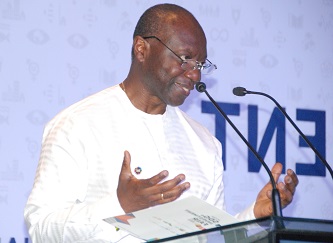
Standard and Poor (S &P) Global, an international rating agency, has rated the Ghanaian economy positively in its latest assessment of the country.
S&P Global in its latest assessment rated Ghana at ‘B-/B’ with a stable outlook.
The latest rating affirmed Ghana’s ‘B-/B’ rating with a stable outlook, which S&P Global did in February 4, 20201.”
A statement on S&P Global latest rating on Ghana made available to the Ghanaian Times, said the country’s positive rating was influenced by “Ghana’s solid growth prospects–with real Gross Domestic Product (GDP) growth projected to average close to five per cent per year over 2022-2025–as well as its relatively transparent and responsive political institutions and largely market-oriented economy. Since 2005, per capita GDP in dollar terms has more than doubled, reaching a still low $2,373 in 2021, with growth per person over the past 15 years averaging 3.5 per cent.”
“Ghana is one of the most open economies in Africa, with exports equal to one-third of GDP. The largest two sectors, mining and hydrocarbons, account for about 70 per cent of all exports. Because of Ghana’s relatively diversified commodity base of gold, oil, and cocoa, Ghana’s terms of trade have remained fairly stable, with a 10-year average standard deviation of 3.4 per cent. We expect these offsetting trends could continue over the medium term,” it said.
It added “Our ratings on Ghana remain constrained by weak public finances, although recent commitments by the governing party to impose a 20 per cent cut to discretionary spending will, under our projections, reduce expenditure by over one per cent of GDP during 2022.
That it said, implied a 2.8 percentage point narrowing of the headline cash general government deficit to 9.4 per cent of GDP in 2022, including arrears payments of 0.4 per cent of GDP and energy sector transfers of one per cent of GDP (versus the government’s projection of 7.9 per cent of GDP for the overall cash deficit).
S&P Global said stepped up fiscal consolidation and solid growth should put debt to GDP on a downward path.
However, it said Ghana’s debt ratio remains acutely vulnerable to exchange rate movements, as well as growth, or terms of trade shocks. External general government debt, including non-resident holdings of domestic debt, is equivalent to 44 per cent of GDP, according to our estimates. An even greater concern is the cost of financing this debt, at an estimated 47 per cent of government revenue (the government’s estimate is lower at 38 per cent), the second highest level of interest spending globally after Sri Lanka.
It said cutting the cost of debt is likely to require a decade of fiscal tightening, in combination with reforms to boost domestic savings and attract more non-debt sources of external financing.
It said fiscal tightening remained challenging from a political perspective, given Ghana’s short election cycles and the narrowness of the current administration’s parliamentary majority.
S&P Global said the country’s “stable outlook balances Ghana’s high government debt levels and an elevated interest burden against our expectation that government debt to Gross Domestic Product will return to gradual downward trend as growth recovers and fiscal consolation proceeds.”
“Ghana aims to consolidate its large fiscal deficits. In January 2022, authorities announced a 20 per cent cut to spending, excluding interest and wages, likely creating fiscal savings this year of at least one per cent of GDP,” it said.
S&P said “We project that government revenue including grants will increase to 17.2 per cent of GDP by year-end 2022 versus 14 per cent pre-pandemic, reflecting the introduction of new taxes, including this year’s pending electronic transactions levy.”
It said fiscal tightening would lead to slightly slower GDP growth of about 4.2 per cent in 2022 versus 5.0 per cent in2021, before accelerating again and averaging just under five per cent between 2021 and 2024.
“If the planned fiscal measures bear fruit, we project that net general government debt will stabilise at 77 per cent of GDP this year, before gradually declining to 75 per cent in 2025. As a consequence, we affirmed our ‘B-/B’ local and foreign currency ratings. The outlook is stable,” S&P Global, said.
On the downside scenario, it said “We could lower the rating in the next six to 12 months if we see further deterioration of Ghana’s fiscal metrics, either due to recurring wide fiscal deficits or the materialisation of contingent liabilities in the financial or energy sectors. Pressure on the ratings could also materialise.”
“Upside scenario, we could raise our ratings should Ghana achieve more substantial budgetary consolidation than our current forecasts imply, without jeopardising the government’s ability to maintain balanced economic growth. Under this scenario, we would expect policy choices to put net general government debt on a steep downward path, lengthen debt maturities, and lower the cost of refinancing. An improvement in external performance could boost FX reserve levels, improving our external assessment, and leading to a higher rating.
Meanwhile, Fitch, another international rating agency, had corrected earlier errors in its downgrade of Ghana.
Fitch earlier downgraded Ghana to B- with negative outlook, but corrected to B.
However, Ratings agency, Moody’s has down grade Ghana’s long-term issuer and senior unsecured debt ratings to Caa1 from B3 and changed the economic outlook to stable from negative.
The down grade to Caa1 reflects the increasingly difficult task the government faces addressing its intertwined liquidity and debt challenges, Myjoyonline reported.
“Weak revenue generation constrains government’s budget flexibility and tight funding conditions on international markets have forced the government to rely on costly debt with shorter maturity,” it said.
Moody’s estimates that interest payments will absorb more than half of the government’s revenue over the foreseeable future, which is exceptionally high compared to peers at all rating levels.
Experts believe the downgrades of African countries by international rating agencies were unusual as about 48 countries suffered credit rating downgrade following COVID-19.
International Monetary Fund said COVID-19 had seen debt in developed economies collectively surged 20 per cent percentage to 124 per cent of GDP.
BY KINGSLEY ASARE







